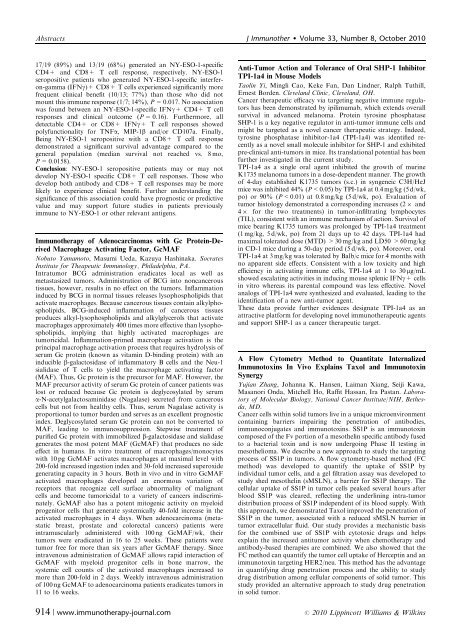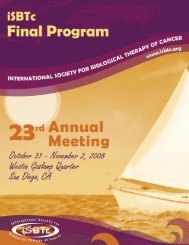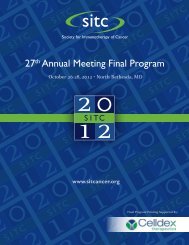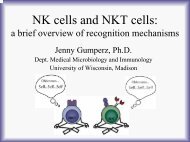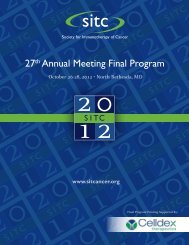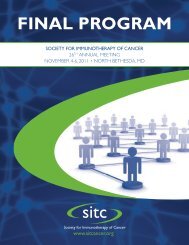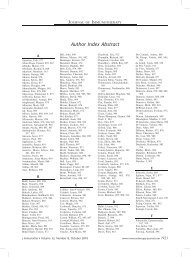Abstracts for the 25th Annual Scientific Meeting of the International ...
Abstracts for the 25th Annual Scientific Meeting of the International ...
Abstracts for the 25th Annual Scientific Meeting of the International ...
You also want an ePaper? Increase the reach of your titles
YUMPU automatically turns print PDFs into web optimized ePapers that Google loves.
<strong>Abstracts</strong> J Immuno<strong>the</strong>r Volume 33, Number 8, October 2010<br />
17/19 (89%) and 13/19 (68%) generated an NY-ESO-1-specific<br />
CD4+ and CD8+ T cell response, respectively. NY-ESO-1<br />
seropositive patients who generated NY-ESO-1-specific interferon-gamma<br />
(IFNg)+ CD8+ T cells experienced significantly more<br />
frequent clinical benefit (10/13; 77%) than those who did not<br />
mount this immune response (1/7; 14%), P = 0.017. No association<br />
was found between an NY-ESO-1-specific IFNg+ CD4+ T cell<br />
responses and clinical outcome (P = 0.16). Fur<strong>the</strong>rmore, all<br />
detectable CD4+ or CD8+ IFNg+ T cell responses showed<br />
polyfunctionality <strong>for</strong> TNFa, MIP-1b and/or CD107a. Finally,<br />
Being NY-ESO-1 seropositive with a CD8+ T cell response<br />
demonstrated a significant survival advantage compared to <strong>the</strong><br />
general population (median survival not reached vs. 8 mo,<br />
P = 0.0158).<br />
Conclusion: NY-ESO-1 seropositive patients may or may not<br />
develop NY-ESO-1 specific CD8+ T cell responses. Those who<br />
develop both antibody and CD8+ T cell responses may be more<br />
likely to experience clinical benefit. Fur<strong>the</strong>r understanding <strong>the</strong><br />
significance <strong>of</strong> this association could have prognostic or predictive<br />
value and may support future studies in patients previously<br />
immune to NY-ESO-1 or o<strong>the</strong>r relevant antigens.<br />
Immuno<strong>the</strong>rapy <strong>of</strong> Adenocarcinomas with Gc Protein-Derived<br />
Macrophage Activating Factor, GcMAF<br />
Nobuto Yamamoto, Masumi Ueda, Kazuya Hashinaka. Socrates<br />
Institute <strong>for</strong> Theapeutic Immunology, Philadelphia, PA.<br />
Intratumor BCG administration eradicates local as well as<br />
metastasized tumors. Administration <strong>of</strong> BCG into noncancerous<br />
tissues, however, results in no effect on <strong>the</strong> tumors. Inflammation<br />
induced by BCG in normal tissues releases lysophospholipids that<br />
activate macrophages. Because cancerous tissues contain alkylphospholipids,<br />
BCG-induced inflammation <strong>of</strong> cancerous tissues<br />
produces alkyl-lysophospholipids and alkylglycerols that activate<br />
macrophages approximately 400 times more effective than lysophospholipids,<br />
implying that highly activated macrophages are<br />
tumoricidal. Inflammation-primed macrophage activation is <strong>the</strong><br />
principal macrophage activation process that requires hydrolysis <strong>of</strong><br />
serum Gc protein (known as vitamin D-binding protein) with an<br />
inducible b-galactosidase <strong>of</strong> inflammatory B cells and <strong>the</strong> Neu-1<br />
sialidase <strong>of</strong> T cells to yield <strong>the</strong> macrophage activating factor<br />
(MAF). Thus, Gc protein is <strong>the</strong> precursor <strong>for</strong> MAF. However, <strong>the</strong><br />
MAF precursor activity <strong>of</strong> serum Gc protein <strong>of</strong> cancer patients was<br />
lost or reduced because Gc protein is deglycosylated by serum<br />
a-N-acetylgalactosaminidase (Nagalase) secreted from cancerous<br />
cells but not from healthy cells. Thus, serum Nagalase activity is<br />
proportional to tumor burden and serves as an excellent prognostic<br />
index. Deglycosylated serum Gc protein can not be converted to<br />
MAF, leading to immunosuppression. Stepwise treatment <strong>of</strong><br />
purified Gc protein with immobilized b-galactosidase and sialidase<br />
generates <strong>the</strong> most potent MAF (GcMAF) that produces no side<br />
effect in humans. In vitro treatment <strong>of</strong> macrophages/monocytes<br />
with 10 pg GcMAF activates macrophages at maximal level with<br />
200-fold increased ingestion index and 30-fold increased superoxide<br />
generating capacity in 3 hours. Both in vivo and in vitro GcMAF<br />
activated macrophages developed an enormous variation <strong>of</strong><br />
receptors that recognize cell surface abnormality <strong>of</strong> malignant<br />
cells and become tumoricidal to a variety <strong>of</strong> cancers indiscriminately.<br />
GcMAF also has a potent mitogenic activity on myeloid<br />
progenitor cells that generate systemically 40-fold increase in <strong>the</strong><br />
activated macrophages in 4 days. When adenocarcinoma (metastatic<br />
breast, prostate and colorectal cancers) patients were<br />
intramuscularly administered with 100 ng GcMAF/wk, <strong>the</strong>ir<br />
tumors were eradicated in 16 to 25 weeks. These patients were<br />
tumor free <strong>for</strong> more than six years after GcMAF <strong>the</strong>rapy. Since<br />
intravenous administration <strong>of</strong> GcMAF allows rapid interaction <strong>of</strong><br />
GcMAF with myeloid progenitor cells in bone marrow, <strong>the</strong><br />
systemic cell counts <strong>of</strong> <strong>the</strong> activated macrophages increased to<br />
more than 200-fold in 2 days. Weekly intravenous administration<br />
<strong>of</strong> 100 ng GcMAF to adenocarcinoma patients eradicates tumors in<br />
11 to 16 weeks.<br />
Anti-Tumor Action and Tolerance <strong>of</strong> Oral SHP-1 Inhibitor<br />
TPI-1a4 in Mouse Models<br />
Taolin Yi, Mingli Cao, Keke Fan, Dan Lindner, Ralph Tuthill,<br />
Ernest Borden. Cleveland Clinic, Cleveland, OH.<br />
Cancer <strong>the</strong>rapeutic efficacy via targeting negative immune regulators<br />
has been demonstrated by ipilimumab, which extends overall<br />
survival in advanced melanoma. Protein tyrosine phosphatase<br />
SHP-1 is a key negative regulator in anti-tumor immune cells and<br />
might be targeted as a novel cancer <strong>the</strong>rapeutic strategy. Indeed,<br />
tyrosine phosphatase inhibitor-1a4 (TPI-1a4) was identified recently<br />
as a novel small molecule inhibitor <strong>for</strong> SHP-1 and exhibited<br />
pre-clinical anti-tumors in mice. Its translational potential has been<br />
fur<strong>the</strong>r investigated in <strong>the</strong> current study.<br />
TPI-1a4 as a single oral agent inhibited <strong>the</strong> growth <strong>of</strong> murine<br />
K1735 melanoma tumors in a dose-dependent manner. The growth<br />
<strong>of</strong> 4-day established K1735 tumors (s.c.) in syngeneic C3H/HeJ<br />
mice was inhibited 44% (P60 mg/kg<br />
in CD-1 mice during a 50-day period (5 d/wk, po). Moreover, oral<br />
TPI-1a4 at 3 mg/kg was tolerated by Balb/c mice <strong>for</strong> 4 months with<br />
no apparent side effects. Consistent with a low toxicity and high<br />
efficiency in activating immune cells, TPI-1a4 at 1 to 30 mg/mL<br />
showed escalating activities in inducing mouse splenic IFNg+ cells<br />
in vitro whereas its parental compound was less effective. Novel<br />
analogs <strong>of</strong> TPI-1a4 were syn<strong>the</strong>sized and evaluated, leading to <strong>the</strong><br />
identification <strong>of</strong> a new anti-tumor agent.<br />
These data provide fur<strong>the</strong>r evidences designate TPI-1a4 as an<br />
attractive plat<strong>for</strong>m <strong>for</strong> developing novel immuno<strong>the</strong>rapeutic agents<br />
and support SHP-1 as a cancer <strong>the</strong>rapeutic target.<br />
A Flow Cytometry Method to Quantitate Internalized<br />
Immunotoxins In Vivo Explains Taxol and Immunotoxin<br />
Synergy<br />
Yujian Zhang, Johanna K. Hansen, Laiman Xiang, Seiji Kawa,<br />
Masanori Onda, Mitchell Ho, Raffit Hassan, Ira Pastan. Laboratory<br />
<strong>of</strong> Molecular Biology, National Cancer Institute/NIH, Be<strong>the</strong>sda,<br />
MD.<br />
Cancer cells within solid tumors live in a unique microenvironment<br />
containing barriers impairing <strong>the</strong> penetration <strong>of</strong> antibodies,<br />
immunoconjugates and immunotoxins. SS1P is an immunotoxin<br />
composed <strong>of</strong> <strong>the</strong> Fv portion <strong>of</strong> a meso<strong>the</strong>lin specific antibody fused<br />
to a bacterial toxin and is now undergoing Phase II testing in<br />
meso<strong>the</strong>lioma. We describe a new approach to study <strong>the</strong> targeting<br />
process <strong>of</strong> SS1P in tumors. A flow cytometry-based method (FC<br />
method) was developed to quantify <strong>the</strong> uptake <strong>of</strong> SS1P by<br />
individual tumor cells, and a gel filtration assay was developed to<br />
study shed meso<strong>the</strong>lin (sMSLN), a barrier <strong>for</strong> SS1P <strong>the</strong>rapy. The<br />
cellular uptake <strong>of</strong> SS1P in tumor cells peaked several hours after<br />
blood SS1P was cleared, reflecting <strong>the</strong> underlining intra-tumor<br />
distribution process <strong>of</strong> SS1P independent <strong>of</strong> its blood supply. With<br />
this approach, we demonstrated Taxol improved <strong>the</strong> penetration <strong>of</strong><br />
SS1P in <strong>the</strong> tumor, associated with a reduced sMSLN barrier in<br />
tumor extracellular fluid. Our study provides a mechanistic basis<br />
<strong>for</strong> <strong>the</strong> combined use <strong>of</strong> SS1P with cytotoxic drugs and helps<br />
explain <strong>the</strong> increased antitumor activity when chemo<strong>the</strong>rapy and<br />
antibody-based <strong>the</strong>rapies are combined. We also showed that <strong>the</strong><br />
FC method can quantify <strong>the</strong> tumor cell uptake <strong>of</strong> Herceptin and an<br />
immunotoxin targeting HER2/neu. This method has <strong>the</strong> advantage<br />
in quantifying drug penetration process and <strong>the</strong> ability to study<br />
drug distribution among cellular components <strong>of</strong> solid tumor. This<br />
study provided an alternative approach to study drug penetration<br />
in solid tumor.<br />
914 | www.immuno<strong>the</strong>rapy-journal.com r 2010 Lippincott Williams & Wilkins


